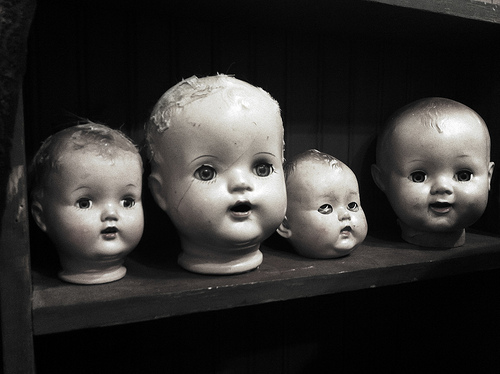I don’t believe in ghosts, I believe in history.
That’s the voice that speaks to us from beyond the grave. It is all around us, speaking out to us wherever we go, but only some of us can hear it (or choose to). It doesn’t need to have the magic of the occult, the mystery of the paranormal, to get its strength. For me the voice of history can be loud and clear, and sometimes scary, without the metaphors of ghosts. But that’s not true for everyone, so perhaps it is natural that popular culture has taken historical artifacts in this direction.
I keep running into examples in TV and film of what I think of as the “Undead Object,” an artifact that has taken on a supernatural life of its own long after the demise of the people who made or used it. Perhaps you’ve had similar thoughts when watching Ghostbusters, Child’s Play, Raiders of the Lost Ark, The Mummy, Tomb Raider, Harry Potter – oh, and there’s the Librarian series, which I haven’t actually watched yet – I have to get my hands on that. Many of these are concerned with objects that derive their power from a sacred connection, but think of the term sacred as relative.
I started thinking about all of this when the TV show Warehouse 13 first appeared back in 20091. I was intrigued by the premise – that a pair of Secret Service agents are responsible for tracking down supernatural artifacts (including Lewis Carroll’s mirror and Edgar Allan Poe’s pen) and packing them safely away in the warehouse, where they can’t hurt anyone. The issue of access to historical objects is one that’s very important to me, so I’m fascinated by the vision of a collection manager hoarding things carefully away. It makes me think about how museums perhaps conspire in developing this kind of aura around an object. Really, when an artifact is packed away in a drawer, or even out on view but behind glass, most of the time it’s to protect the object from its audience – but how clever to get the general public to think it’s the other way around – that we need to be protected from it.
Certainly the object behind glass easily comes to have that feeling of being Undead – once so connected to living, breathing people, but now cut off from them. A phrase in Sherry Turkle’s book Evocative Objects: Things We Think With (2007), started to articulate some of this for me:
Some [objects], however, seem intrinsically evocative – for example, those with a quality we might call uncanny. Freud said we experience as uncanny those things that are “known of old yet unfamiliar.” The uncanny is not what is most frightening and strange. It is what seems close, but “off,” distorted enough to be creepy. It marks a complex boundary that both draws us in and repels . . . (p. 8)
As much as we may love to visit museums and historic estates, architecture and objects can indeed be creepy: costumes on mannequins without heads, objects untouchable, enshrined behind glass. Most of the time, attempts to include context are brief, and so much is missing, leaving the object feeling empty, stolen. The objects feel incomplete without a connection to the people who made them and used them. They feel sad, longing:
The chair that no one will ever again sit in,
the cup that no one will ever again drink from
the dress that no one will ever again wear.
I certainly am not advocating that we sit, drink, wear. With sitting, drinking, wearing, we wear objects out, and their voices are silenced sooner than later. This is why I feel so lucky to have had the training and experience to know how to properly handle clothing artifacts, so that I can work with such objects hands on, in a way that is less formal and more personal. In this way I have more of a direct connection to the people implicated by the object, so the voice of history that I hear is friendlier and more complete, not as much a mystery as an open conversation. I get to flesh out this conversation beyond the brief exchange with an object behind glass and its tombstone2 label on the wall. This is the conversation that I want to open to a wider audience, using the access that digital tools can provide.
But I recently found that even the aspect of digitization has been touched by the supernatural when played out on TV. When I was originally watching Buffy the Vampire Slayer on TV the first time around, how did I miss the episode called “I Robot You Jane”? I’m starting to watch the series over with my daughter, and I was delighted to find this episode, which specifically addresses the power of a demon entering the internet through a scanned book. What an incredible warning to digital librarians like myself! However, in the real world, the general concern with digitization is just the opposite – that the digital surrogate can never come close to capturing the aura of the original object. The digital librarian’s challenge is to find the right balance of capturing some of the essence of the object while paying respect to its physical original.
Regardless, the fact is, I see dead people.
Sitting in the chair,
drinking from the cup,
wearing the dress.
It’s not spooky at all. It’s just history, an appreciation of what can be studied from the past, coupled with imagination. I want to help you to see them, too, and to hear their voices.
1Unfortunately, the show just wasn’t as good as its premise, in my opinion, and I don’t think I’ve watched it since 2009.
2Did you ever think about why they call it a tombstone label? Dead? Or Undead?
References
Turkle, S. (2007). Evocative Objects: Things We Think With. The MIT Press.






